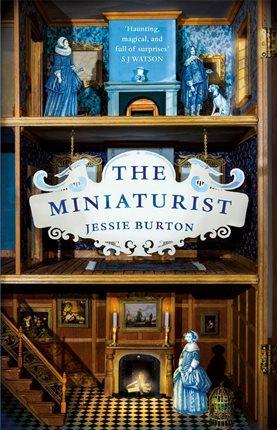 I am writing fewer reviews these days so only pick the books which really stand out for me. That is true of The Miniaturist by Jessie Burton, a debut which is now being released or eagerly anticipated all over the world. It was acquired by Picador in the UK for a six figure sum and went to auction in more than thirty countries. This kind of phenomenal success and the media attention which goes with it is very rare for a debut author and brings a lot of pressure to deliver.
I am writing fewer reviews these days so only pick the books which really stand out for me. That is true of The Miniaturist by Jessie Burton, a debut which is now being released or eagerly anticipated all over the world. It was acquired by Picador in the UK for a six figure sum and went to auction in more than thirty countries. This kind of phenomenal success and the media attention which goes with it is very rare for a debut author and brings a lot of pressure to deliver.
The proof sat on my bookshelf for a good couple of months before curiosity got the better of me. The Miniaturist is set in seventeenth-century Amsterdam (prompting inevitable comparisons with Tracy Chevalier’s Girl with a Pearl Earring) and I am not generally a fan of historical fiction set in the distant past.
This ceased to matter the moment I began reading. It’s a sizeable novel and the fact that it only took me three days to finish is telling.
The Miniaturist is narrated in the third person, present tense in the perspective of eighteen-year-old Nella, an unsophisticated country girl who has recently been strategically married off to wealthy Amsterdam merchant Johannes Brandt, a man twice her age. Also present under his roof are his forbidding unmarried sister Marin and two servants: Cordelia, who grew up in the local orphanage, and Otto, a black manservant and former slave.
Unsurprisingly as a very young woman new to bourgeois society and city life, Nella finds it a challenge to adjust. She soon realises that all is not as it seems in the Brandt household. From the very beginning, Nella’s impressions and experiences come across in an exceptionally vivid and engaging way, which explains why this novel is able to win over people who think they don’t enjoy historical fiction. The characterisation and relationships have a universal resonance which transcend the period, although the marked feminist slant seems more of our time than hers.
As portrayed, Amsterdam is a complex and fascinating place: a society struggling to reconcile the conflicting forces of commerce and religion, where women are subjugated and yet long to exert some control, where hypocrisy and deceit reign. It’s fertile territory. Whilst historical accuracy will be a consideration for some, the fact that the author succeeds in creating such a vibrant and authentic-feeling world was enough for me. It is fiction, after all.
That accomplishment owes much to Burton’s sumptuous and highly visual prose. The scenes involving food were a feast in themselves:
Nella examines the sugar loaf, a conical, glittering structure the length of her forearm, the crystals tightly compacted. [...] The first white shaving lands in a curl at the base of the cone. [...] Nella feels the shaving melt in her mouth, sweet and granular, vanished in a moment. It leaves a sheen of vanilla behind, and tacks her tongue onto her palate.
Being a newly-wed wife is not at all as Nella imagined but a welcome distraction comes in the form of her husband’s wedding gift, a cabinet dollshouse like the one in the Rijksmuseum which inspired the novel. A replica of the elegant Brandt residence, it will be furnished by the enigmatic miniaturist of the title, whose powers extend beyond the practical and artistic. Again, there are some gorgeous descriptions of her creations:
Eight dolls are laid out on a stretch of blue velvet. So lifelike, so delicate; they are items of such humanly unreachable perfection. Nella feels like a giant, picking one up as if it might break[...] Wearing a neat gray dress, her minature stares up, a look of faint surprise across her frozen face. In one of her tiny hands is an empty birdcage, its door swinging open wide. Nella feels a strange sensation in her body, as if needles are pricking the inside of her skin. In the doll’s other hand is a minuscule note written in neat black capitals: THINGS CAN CHANGE.
Once I realised this novel had something of the magical, I was seduced by it and the hyper-realist sensor that questions the plausibility of everything was switched off. Unfortunately, the book does have one significant weakness: the mystery surrounding the miniaturist is obviously one of the main strands of the narrative and is for a long time very compelling, so it was disappointing not to see that carried through. A rather contrived scene towards the end left me feeling toyed with and suggested indecision about where to take this part of the story. It will be interesting to hear what other readers make of it.
However, there are enough other layers for this flaw not to be fatal and they are more successfully sustained with good handling of suspense and a satisfying blend of developments which could and couldn’t be guessed at (different for everyone, of course.) The author has the confidence to bring the story to a powerful and moving conclusion which avoids sentimentality.
Jessie Burton is clearly a writer of talent and imagination. The merits of The Miniaturist are bound to be hotly debated; opinions will vary as they always do. Mine is that this is a genuinely enchanting novel.
Is The Miniaturist on your wishlist?
*POSTCRIPT*
On Thursday I am delighted that Linda Grant will be joining me on the Literary Sofa to discuss her latest novel Upstairs at the Party, one of my Summer Reads 2014.

